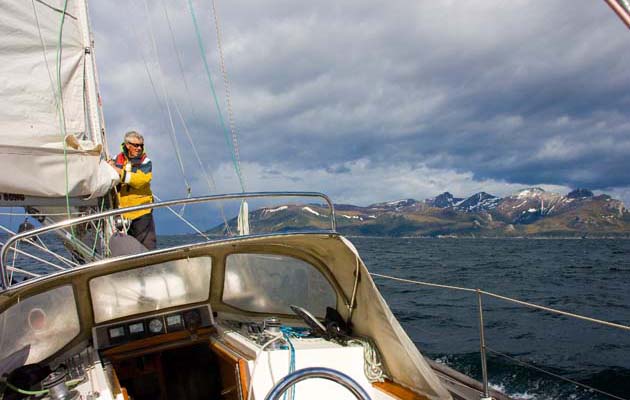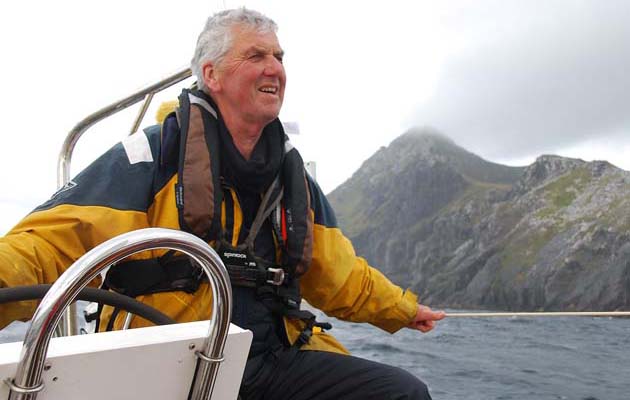After more than two months at sea, a series of errors left solo sailor Paul Heiney precariously anchored off the Azores with few options
The kettle was hardly warm before I decided that I wasn’t in a very good position at all. I was desperate to get to Horta, dreaming of cafes and coffees, fresh bread, the crunch of a green apple, and all the things you really miss after 65 days at sea.
Horta seemed close enough to touch, hardly a centimetre away on my chart of the entire North Atlantic Ocean, yet it was as attainable as a mirage. I knew that with north-easterly headwinds up to 40 knots, and no prospect of it moderating for several days, it might as well have been a thousand miles away.
That was my first thought. By the time the water in the kettle had started to sing another crossed my mind – the diesel tank was empty.
I had known this for some weeks and been quite relaxed about it because the entrance to Horta is straightforward with plenty of room to sail in and anchor. But I needed the engine for other things.
With solar panels and bright sunshine I had been self-sufficient in electricity. Sailing north out of the tropics, though, the sun had retreated for days on end behind ever greyer skies, the flow of charge faded into a trickle, and the watermaker became a luxury too far – water was now getting low.
Mounting concern
The food locker wasn’t too enticing either. I can’t claim I was anywhere near starvation, but choice was no longer available to me.
It is strange how certain foods bought with enthusiasm at the time never seem to leave the locker, which explains why one day you will search for something to eat, as I did, and find only a tin of runner beans and a can of stewed rhubarb.

The kettle boiled. I carved off the last slice from a loaf I had baked a few days before and chewed things over.
I decided that of all the concerns that were floating around, those which I had listed so far were the least of them. I honestly thought that if I tried to beat any further in winds like these then the boat was simply going to fall apart. I knew it for sure. How could she take any more?
I had already sailed her from my home port of Dartmouth the 9,000 miles to Cape Horn, and most of the way back. I had bashed her through the Roaring Forties and into the Furious Fifties, been laid flat by gusts in the Beagle Channel, taken tons of water over the deck in that nasty bit of sea between South America and the Falkland Islands. How much more of this could she take?
I was, of course, asking this question of the boat when I was really asking it of me. After 60 long days on your own, you may believe yourself to be thinking straight but it is doubtful if you are.
So the fear persisted that the poor old boat was now in some kind of intensive care and needed careful nursing, when the truth was that I was the patient.
I drank the tea wedged in the companionway where I can look down the deck, be within easy reach of the cockpit yet braced against the motion, and sheltered by the sprayhood, and came to a conclusion about what I should do next. I decided I’d had enough beating to windward, and that I would heave-to.
Heaving-to is quite a pleasant thing to do, if you have a boat that will behave. Wild Song is a Victoria 38, designed by Chuck Paine, who has always had the ability to combine a graceful line with sea-keeping ability.
Wild Song is no exception. She never fails to catch an eye as she sails into a harbour, people always speak fondly of her lines and grace, “Ah,” they coo, “you have a classic there.”
My doubts about her integrity proved to be groundless: she was so strongly built that when she finally returned home she was good for another 10,000 miles. If I’d known that then, I daresay I would have put her to the wind and sailed on. But I didn’t. My judgement had gone.

Locking the wheel to heave to.
What would Larry Pardey do?
Once I had pulled down the third reef in the main and lashed the wheel, she came to a graceful halt and bobbed like a cork over the building waves lying some 30 degrees off the wind, falling away to 45 or 50 before coming back up again.
I did the kitchen paper test, advocated by that accomplished cruising couple, Lin and Larry Pardey, and took a sheet of kitchen paper, dropping it over the lee side abreast the cockpit, and watching it. It should move neither fore nor aft.
If the paper moves then you are making way which is not what you are trying to achieve. You need to be properly parked to be safe.
The wind blew louder and the occasional crash of green water on the deck grew heavier but I felt quite content. Until one breaker fell with great force, the cracking sound convincing me the hull had been split open like a nut.
But the dear old boat just shrugged it off and there we sat, as if we were on our holidays.
If I am honest, my trip down to Cape Horn had been an easy one and I guessed I was now paying the price. Heading south from Europe is a downhill ride, first through the Portuguese tradewinds, then the north-east Trades blowing hot and sandy off the Sahara desert, before hitting the Doldrums where progress comes to a complete halt in this eerie stretch of water north of the Equator where no wind blows with any certainty.

After that I picked up a south-east wind which didn’t leave me until I was within the Roaring Forties which, for much of the time roared with all the ferocity of a pussy cat. Perhaps I was lucky.
For the return trip, I took a departure from Piriapolis, Uruguay, on the northern side of the River Plate. Five whole days of strong south-westerly winds got me swiftly 400 miles offshore where, after a calm, the wind then filled in from the north-east and I was hard on it for a couple of weeks in mostly light weather, slowly creeping north almost to the Equator.
Then the computer died. It seemed a small thing at the time, but it was to lead to my first big mistake.
I had been tethering it to a satellite phone and downloading GRIB files, which had proved accurate and useful. Now I was without any kind of forecast.
A friend back home, Malcolme, sent me his reading of the GRIBs as a text message, but it is not the same as having an overview yourself.
With Malcolme forecasting no wind at all for several hundred miles ahead I foolishly concluded that the Doldrums had moved a good way south (they are quite mobile, but not that mobile). So I started the engine to make use of some of the 400 or so miles of diesel still in the tank, holding back ten litres to get me into Horta.
It was a grim moment when the engine spluttered and died while the deceptive fuel gauge still showed me to have 20 litres left. The Azores were still 700 miles away.
All I could do was sail patiently onwards, which I did quite happily until Malcolme’s daily text message came through. I was by now 200 miles south-west of Horta.
‘Don’t blame the messenger but….’ he began. This was the forecast of headwinds of 40 knots that was eventually to lead me to heave to.




